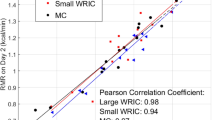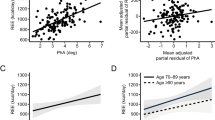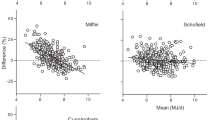Abstract
Objective:
The primary aims of this trial were to evaluate the reproducibility of a portable handheld calorimeter (Medgem) in a clinical population, and to compare its measures with a calorimeter in typical use with these patients.
Design:
Cross-sectional clinical validation study.
Setting:
Outpatient Clinical Research Center.
Subjects:
A total of 24 stable home nutrition support patients.
Interventions:
In random order three measures of resting metabolic rate (RMR) were taken after a 4-h fast, 15 min rest and 2-h abstention from exercise. Two measures were taken with the same Medgem (MG) and one with the traditional calorimeter (Deltatrac). Reproducibility of MG measures and their comparability to a Deltatrac measure were assessed by Bland–Altman analysis, with >±250 kcal/day established a priori as a clinically unacceptable error. In addition, disagreement between the two types of measures was defined as greater than 10% difference.
Results:
The mean difference between two MG measures was −6.8 kcal/day, with limits of agreement between 233 and −247 kcal/day and clinically acceptable. The mean difference between the Deltatrac and mean of two MG measures was −162 kcal/day, with limits of agreement between 577 and −253 kcal/day and clinically unacceptable. In all, 80% of the repeated MG RMR measures agreed within 10%, and the mean MG reading agreed with the Deltatrac in 60% of cases.
Conclusions:
RMR obtained using the MG calorimeter has an acceptable degree of reproducibility, and is acceptable to patients. The MG measures, however, are frequently lower than traditional measures and require further validation prior to application to practice in this vulnerable patient group.
Sponsorship:
This research was conducted in part with support from NIH Grant RR00040, and with loan of equipment and technical assistance from Healthetech.
This is a preview of subscription content, access via your institution
Access options
Subscribe to this journal
Receive 12 print issues and online access
$259.00 per year
only $21.58 per issue
Buy this article
- Purchase on Springer Link
- Instant access to full article PDF
Prices may be subject to local taxes which are calculated during checkout


Similar content being viewed by others
References
Bland JM & Altman DG (1986): Statistical methods for assessing agreement between two methods of clinical measurement. Lancet 327, 307–310.
Brooks GA, Butte NF, Rand WM, Flatt JP & Caballero B (2004): Chronicle of the Institute of Medicine physical activity Recommendation: how a physical activity recommendation came to be among dietary recommendations. Am. J. Clin. Nutr. 79 (Supp l), S921–S930.
De Weir JB (1949): New methods for calculating metabolic rate with special reference to protein metabolism. J. Physiol. 109, 1–9.
Feurer I & Mullen J (1986): Bedside measurement of resting energy expenditure and respiratory quotient via indirect calorimetry. Nutr. Clin. Pract. 1, 43–49.
Haugen HA, Melanson EL, Tran ZU, Kearney JT & Hill JO (2003): Variability of measured resting metabolic rate. Am. J. Clin. Nutr. 78, 1141–1144.
Igawa S, Sakamaki M & Miyazaki M (2002): Examination of the reliability of the portable calorimeter. Clin. Exp. Pharm. Phys. 29, 13–15.
Kashiwazaki H, Dejima Y & Suzuki T (1990): Influence of upper and lower thermoneutral room temperatures (20°C) on fasting and post-prandial resting metabolism under different outdoor temperatures. Eur. J. Clin. Nutr. 44, 405–413.
Kinabo JL & Durnin JVGA (1990): Effect of meal frequency on the thermic effect of food in women. Eur. J. Clin. Nutr. 44, 389–395.
Matarese L (1997): Indirect calorimetry: technical aspects. J. Am. Diet. Assoc 97, 154–160.
McClave SA & Snider HL (1992): Use of indirect calorimetry in clinical nutrition. Nutr. Clin. Pract. 7, 207–221.
Nieman D, Trone G & Austin M (2003): A new handheld device for measuring resting metabolic rate and oxygen consumption. J. Am. Diet. Assoc. 103, 588–593.
Reed GW & Hill JO (1996): Measuring the thermic effect of food. Am. J. Clin. Nutr. 63, 164–169.
Reeves MM, Capra S, Bauer J, Davies PSW & Battistutta D (2005): Clinical accuracy of the MedGem™ indirect calorimeter for measuring resting energy expenditure in cancer patients. Eur. J. Clin. Nutr. 59, 603–610.
Schols AMWJ, Schoffelen PFM, Ceulemans H, Wouters EFM & Saris WHM (1992): Measurement of resting energy expenditure in patients with chronic obstructive pulmonary disease in a clinical setting. J. Parent. Ent. Nutr. 16, 364–368.
Shetty PS, Henry CJK, Black AE & Prentice AM (1996a): Energy requirements of adults: an update on basal metabolic rates and physical activity levels. Eur. J. Clin. Nutr. 50 (Supp l), S11–S23.
Shetty PS, Henry CJK, Black AE & Prentice AM (1996b): Energy requirements of adults: an update on basal metabolic rates (BMRs) and physical activity levels (PALs). Eur. J. Clin. Nutr. 50 (Supp l), S11–S23.
St-Onge MP, Rubiano F, Jones A & Heymsfield SB (2003): A new hand-held indirect calorimeter to measure postprandial energy expenditure. Obes. Res. 12, 704–709.
Takala J, Keinanen O, Vaisanen P & Kari A (1989): Measurement of gas exchange in intensive care: laboratory and clinical validation of a new device. Crit. Care Med. 17, 1041–1047.
Tissot S, Delafosse B & Bertrans O (1995): Clinical validation of the Deltatrac monitoring system in mechnically ventilated patients. Intens. Care Med. 21, 149–153.
Ventham JC & Reilly JJ (1999): Reproducibility of resting metabolic rate measurement in children. Br. J. Nutr. 81, 435–437.
Weissman C, Sardan A & Kemper M (1990): In vitro evaluation of a compact metabolic measurement instrument. J. Parent. Ent. Nutr. 14, 216–221.
Acknowledgements
This research was conducted in part with support from NIH Grant RR00040, and with loan of equipment and technical assistance from Healthetech.
Author information
Authors and Affiliations
Corresponding author
Additional information
Pre'cis: The most widely used methods for measuring resting metabolic rate involve indirect calorimetry. This study evaluates the reproducibility of a portable handheld calorimeter and its comparability to a traditional indirect calorimeter in measures of resting metabolic rate in a home nutrition support clinical population.
Guarantor: C Compher.
Contributors: MH, AS and BPK read the final draft of the paper, collaborated in the data collection and share responsibility for the final research.
Rights and permissions
About this article
Cite this article
Compher, C., Hise, M., Sternberg, A. et al. Comparison between Medgem and Deltatrac resting metabolic rate measurements. Eur J Clin Nutr 59, 1136–1141 (2005). https://doi.org/10.1038/sj.ejcn.1602223
Received:
Revised:
Accepted:
Published:
Issue Date:
DOI: https://doi.org/10.1038/sj.ejcn.1602223
Keywords
This article is cited by
-
Assessing resting energy expenditure in overweight and obese adolescents in a clinical setting: validity of a handheld indirect calorimeter
Pediatric Research (2017)
-
Long-term effects of increased dietary polyunsaturated fat from walnuts on metabolic parameters in type II diabetes
European Journal of Clinical Nutrition (2009)
-
Estimating resting energy expenditure in patients requiring nutritional support: a survey of dietetic practice
European Journal of Clinical Nutrition (2008)
-
MedGem Hand‐Held Indirect Calorimeter Is Valid for Resting Energy Expenditure Measurement in Healthy Children
Obesity (2006)



